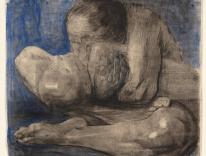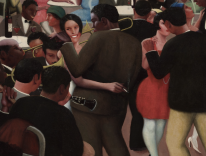If you know just one work by Jasper Johns—arguably the greatest, most influential American artist still alive today—it’s almost certainly his iconic painting Flag, from 1954. At first glance, there’s nothing particularly special or interesting about it, except perhaps that it excludes the stars for Alaska and Hawaii, which hadn’t yet achieved statehood. The work’s dimensions are modest (slightly larger than three by five feet), and its materials are crude (waxy encaustic, oil paint, newspaper collage, and fabric mounted on three separate plywood panels). Apart from smudges, drips, and the odd newspaper line or dated advertisement, closer inspection doesn’t reveal much more. It’s pretty much like every other American flag you’ve ever seen.
But context, as they say, is everything, and Flag bears an extensive mythology. It was in a dream, the twenty-four-year-old Johns once claimed, that his subconscious had conceived the work; he merely went out, scraped together materials, and assembled it the next day. Whatever its origins, Flag took the New York art world by storm. Critics interpreted Johns’s cool, deadpan image as a provocation and a revelation. Flag wasn’t just a wry rebuke of abstract expressionism, with its gestural, improvised brush strokes and its cult of self-assertion. By blurring the line between sign and signified, by collapsing symbol and symbolized, the piece had called into question the representational nature of art itself.
And the rest, as they also say, is history. Johns became an instant celebrity, running in the same circles as avant-garde composer John Cage, choreographer Merce Cunningham, and painter Robert Rauschenberg, Johns’s mentor and one-time lover. Johns’s place in the history of modern American art has been secure ever since. Movements like Pop Art, Conceptualism, and Neo-Dada would be unthinkable without his staid sculptures of beer cans and flashlights, or his serial paintings of flags, numbers, letters, maps, and targets, those “things the mind already knows.” But as two new shows at the Philadelphia Museum of Art and the Whitney Museum in New York powerfully demonstrate, it would be a mistake to limit Johns to his past achievements. He’s been evolving for seven decades, and he continues to create original, thought-provoking art even today, at the age of ninety-one.
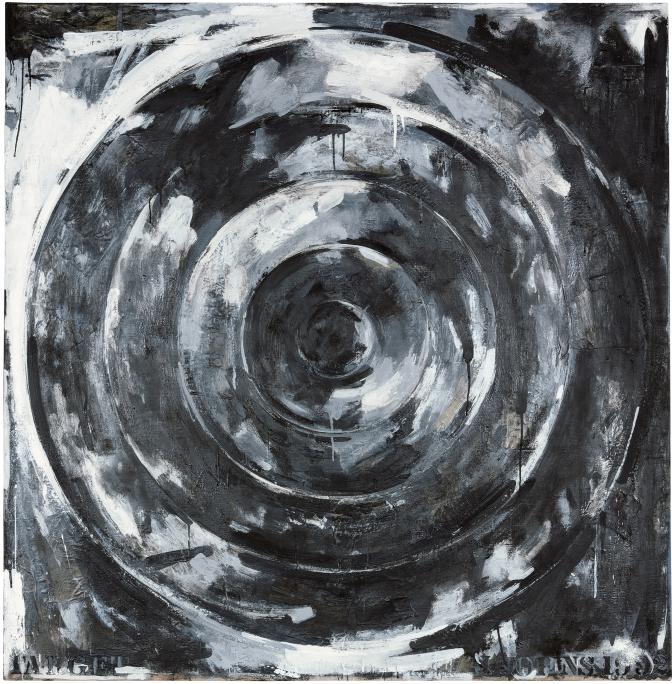
Planned to coincide with the artist’s ninetieth birthday and delayed a year due to the pandemic, Jasper Johns: Mind/Mirror is unique among retrospectives of individual artists. For starters, its scale is unprecedented: nearly five hundred works spread across two cities in two museums, both of which were early champions of Johns and played key roles in his development. There’s also the innovative “mirror” structure itself, which curators Carlos Basualdo and Scott Rothkopf have adapted from the formal doubling Johns frequently employs. The show is billed as a unified whole consisting of two autonomous halves: each gallery in New York corresponds to one in Philadelphia. But this apparent harmony masks deeper disagreements, even rivalries between the two curators. In Philadelphia, Basualdo mounts a more poetic, intuitive show, while Rothkopf’s approach in New York is linear and encyclopedic.
At first, I had trouble getting into it. I’m from Philadelphia but live in New York, so I decided to start at the Whitney. For Johns novices like me, that show can be a lot to take in. It begins with a wall practically plastered in prints, stamped with hermetic iconography drawn from different moments of Johns’s career. A parade of flags, numbers, and targets yields to coffee cans, upside-down chairs, and pieces of bread; after some stick figures and skulls, the whole thing concludes in a swirl of starry constellations and galaxies. I found it unsettling, even frustrating, like I was standing by the roadside in a foreign country, trying to get directions in a language I couldn’t understand. I jotted down a few petulant notes: “Targets—stupid.”
That all changed when I entered the gallery dedicated to Johns’s maps, all variations on the standard U.S. textbook map, complete with stenciled state abbreviations. (The corresponding gallery in Philadelphia is devoted to numbers.) Seated on a bench at the center, I let my eye travel back and forth across the different canvases, many of them massive. Map (1961) is a virtuosic explosion of primary colors, with painted blobs of red, yellow, and blue bursting like bombs; Map (1962–1963), laden with blacks, grays, and whites, makes the same motif feel much heavier, while Two Maps (1965), with its soothing creams, light blues, and tans, does the opposite. As I stopped trying to grasp what Johns’s maps were “about,” my mind relaxed, and I simply sensed the forms and colors around me.
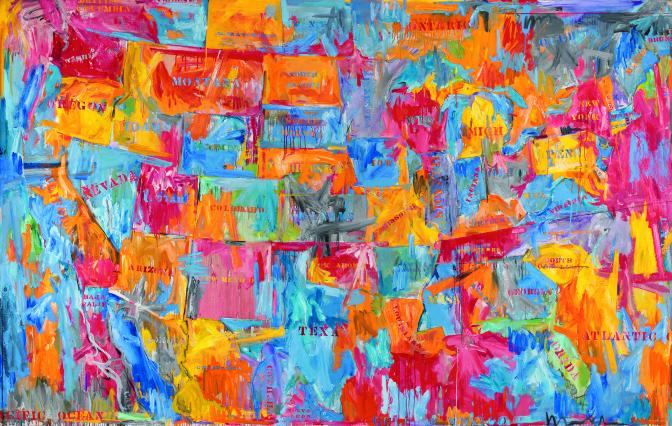
Suddenly Johns’s insight clicked. As it perceives the world visually, the human mind searches, often desperately, for confirmation of what it already knows, rendering the world a mere mirror of itself. Art, particularly visual art, gives us a way of disrupting this habitual process: a map is no longer a map (a flag is no longer a flag, numbers no longer numbers, and so on), but a portal into something deeper, more inchoate, and, Johns might argue, more real.
It’s an insight that Johns has spent the rest of his career wrestling and experimenting with, even as his art shifted away from his early motifs and into more explicitly autobiographical territory, where relationships, places, and the complex memories associated with them become more prominent. Before dropping out of college and moving to New York, Johns grew up in South Carolina. After abruptly falling out with Rauschenberg, Johns returned for a time, purchasing a beach house at Edisto Island, near Charleston, to use as a studio and retreat. The breakup had devastated Johns, and evidence of his anger and sense of betrayal, contained in icy works like Liar, Water Freezes, and Fool’s House—all in gray—is on view in both museums.
But Edisto Island clearly provided a respite, as vividly captured in a series of black-and-white photos of Johns by Ugo Molas. The Italian photographer frames Johns’s tall, slender figure, often awash in sunlight and casting a long shadow, against foaming surf and shifting sands, hinting at the fleetingness of suffering. Peace is present too in Johns’s own large-scale allegory of painting, Studio (1964), where full-size tracings of a canted screen door and spiky palm fronds stand out against a soft grisaille background. Dangling from an unwound coat hanger is a string of empty beer cans—their insides lathered with green, blue, orange, purple, and red paint—and a single silver brush. It’s one of Johns’s most tactile works, and also one of his most entrancing: you can practically taste the beer, smell the paint, and feel the sea breeze.
Johns also looked abroad, especially to Japan, for new sources of inspiration. He first traveled there during his years in the army, spending six months in Sendai in the early 1950s, then again in the mid ’60s, after his show at the 1958 Venice Biennale won him an invitation to Tokyo from prominent Japanese gallerist Kusuo Shimizu and critic Yoshiaki Tōno. (In the show’s catalog, Basualdo suggestively refers to these trips as “pilgrimages.”)
Among the most striking results is Johns’s collaborative Usuyuki series, begun in 1977 with master printmaker Hiroshi Kawanishi and the Simca Print Artists in New York. The title, taken from the name of a princess in an eighteenth century Kabuki play, literally means “light snow.” And that’s just what these variegated paintings and prints recall. In some, pinkish, crystalline cross-hatch patterns dance across the canvases; in others, the light blue pattern gradually fades and disappears, only to reappear in differently colored panels nearby. There’s beauty, Johns suggests, even (and perhaps especially) in evanescence.
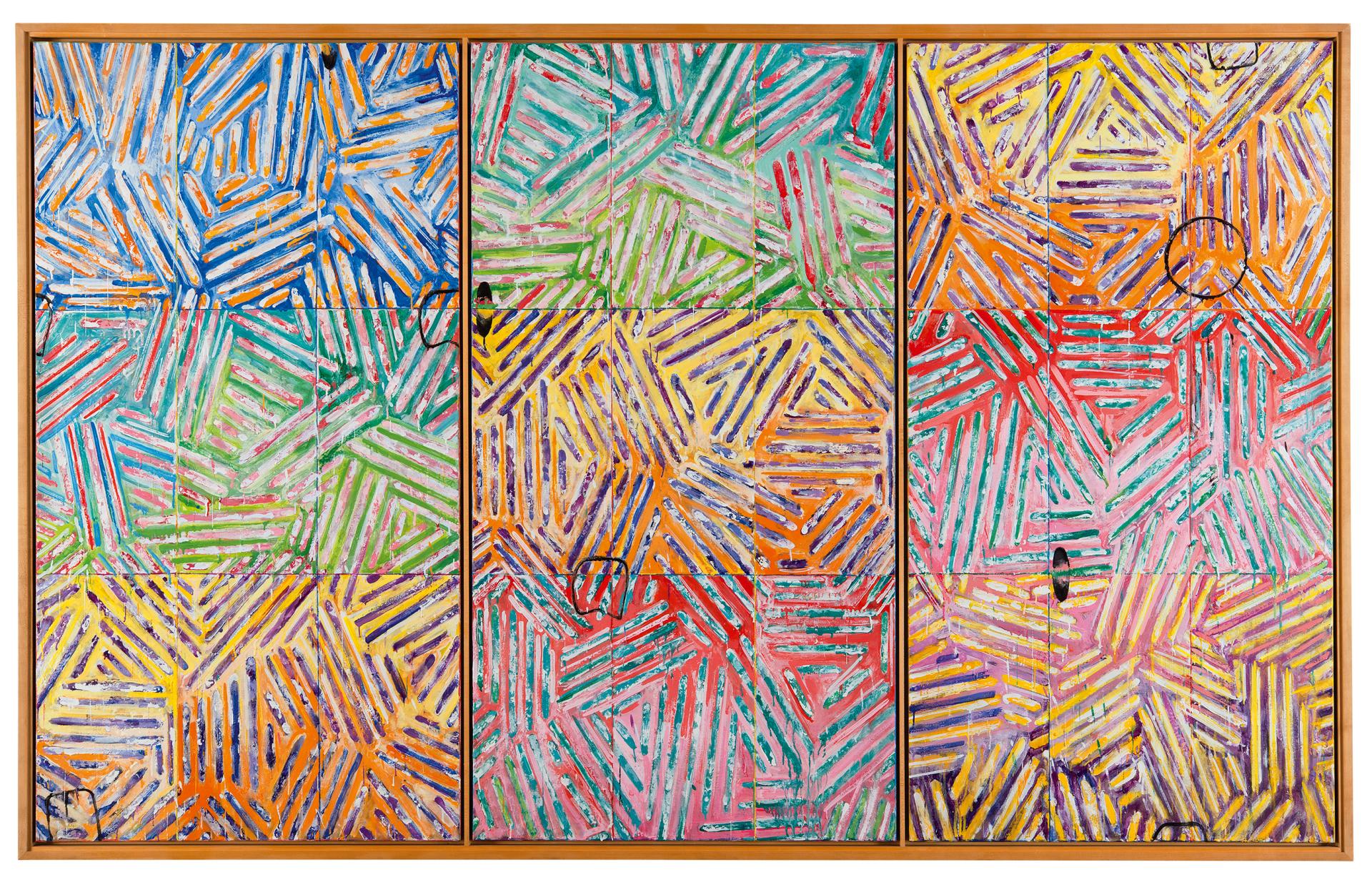
Since the 1990s, Johns has lived alone on a sprawling rural estate in Sharon, Connecticut. He rarely grants interviews (though an authorized biography is now in preparation), and remains tight-lipped about his work, which, even as it adds new elements, continues to revisit and rework earlier patterns and motifs. Much of what he’s produced since the 1980s feels dreamlike and surreal: eyes gaze across spare spaces containing cryptic objects like faucets, watches, and stick figures. Some of it is nightmarish, presenting severed arms mottled by disease (Johns’s response to the AIDS crisis) and anxious black palm prints. Mostly, though, Johns’s recent work evinces a growing familiarity and comfort with death: the New York show features funeral urns, burial shrouds, and shadowy figures standing beside ladders, while in Philadelphia we see clownish skeletons wearing top hats, skipping jump rope, and leaning on canes.
Johns’s most recent works also seem to contain an understated religiosity. Catenary (I Call to the Grave) (1998) is a case in point. Here Johns suspends a white string between the lower left and upper right corners of the frame—an allusion to the thread of human life woven (and eventually cut) by the three fates in Greek mythology. The title, running in capital letters across the bottom, recalls a line from the biblical Book of Job, the speaker expressing a grief that has become unbearable. Next to it Johns stencils his name and the date, mimicking a gravestone, and as if declaring that the words are also his own.
The whole thing is pretty dark, but like all of Johns’s art, it depends on how you look at it. The textual allusions and the colors—at the right of the canvas there’s a harlequin pattern that looks like a dusty church window lit by cloudy light—are indeed somber. But the parabola traced by the string, caused by gravity’s downward force, appears to bend upward gracefully as it lightly traverses the canvas, eventually exceeding its borders. The tension in the string complicates the portrait of death, adding a note of vital dynamism, even hope.
Slice, made at the height of the pandemic lockdowns in 2020, takes this idea one step further. The work’s origins are serendipitous: Johns was waiting for an appointment at the orthopedist’s office when he noticed a hand-drawn cross-section of a human knee, made by a high-school student, Jéan Marc Togodgue. Two years earlier, he’d received another illustration in the mail, this time from an astrophysicist, Margaret Geller, who’d long admired his work. She’d sent him a printout of her team’s “Slice of the Universe,” a map of nearby galaxies. Johns noticed a cluster of galaxies at the center seemingly arranged in the shape of a stick figure—a figure he’d been regularly including in his own work—and in 2020 wrote Geller to tell her that he was working on a painting based on the map.
The result is profound. Slice reproduces Geller’s radial matrix of red, blue, and green dots set against a black field. But here Johns fills it with a knot pattern taken from drawings by Leonardo da Vinci (whose Vitruvian Man, which maps the harmonious proportions of the human body, is another of Slice’s allusions). To the right of Geller’s map we find a reproduction of Togodgue’s illustration of the knee. Johns’s juxtaposition of the small and mundane with the cosmic and infinite recalls the nineteenth century trope of the “sublime” when Romantic artists and poets waxed about the vast, restorative power of nature, whose grandeur dwarfed human beings. It also recalls, at least for me, another biblical text, Psalm 8: “When I see your heavens, the work of your fingers, / the moon and stars that you set in place / What is man that you are mindful of him? … Yet you have made him little less than a god….”
Did Johns intend this? Probably not. But that’s the value and strength of his art. Its “mirror” doesn’t just give you a glimpse into Johns’s mind. It also helps you see into your own.
Please email comments to [email protected] and join the conversation on our Facebook page.
Previous Story
There Will Be Blogs
Next Story
Welcoming the Stranger

